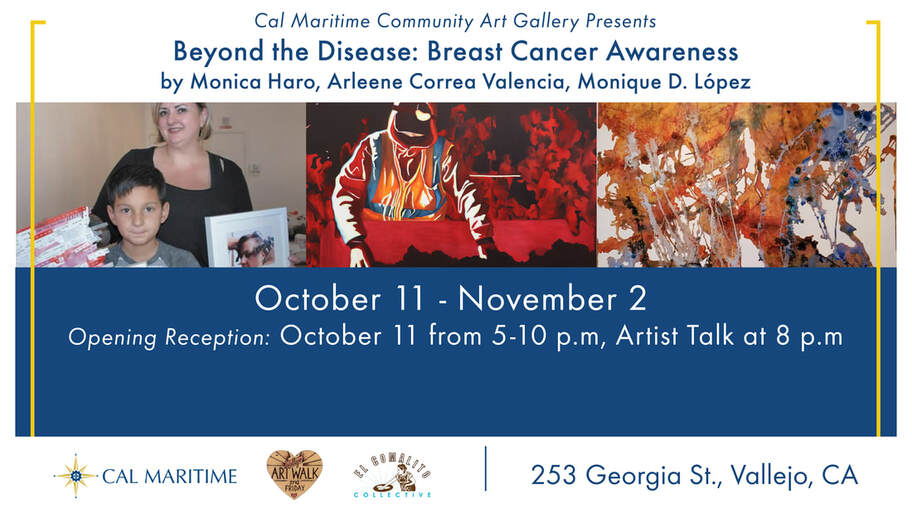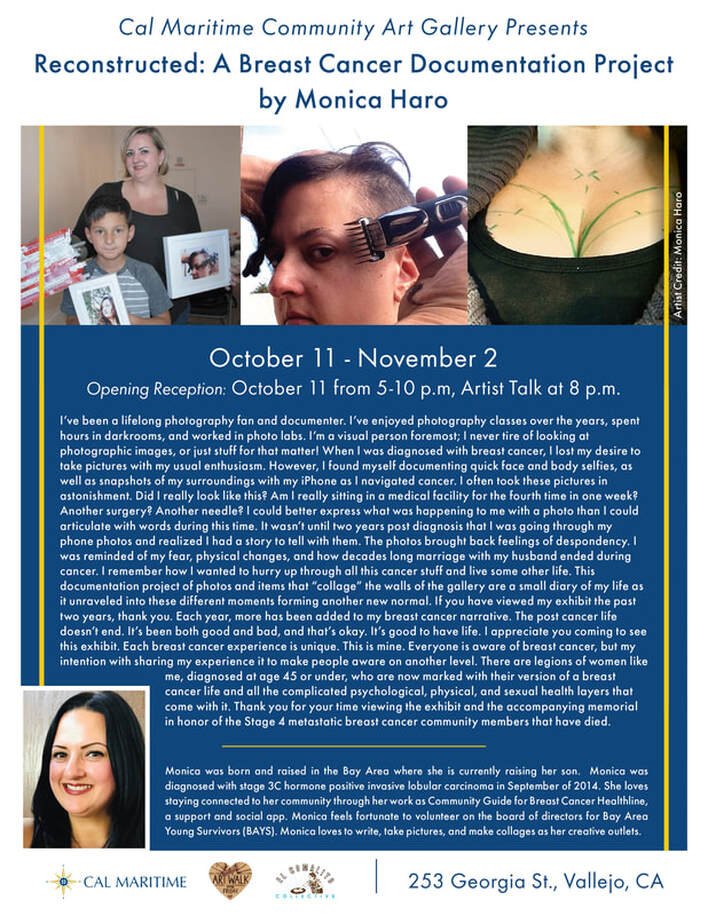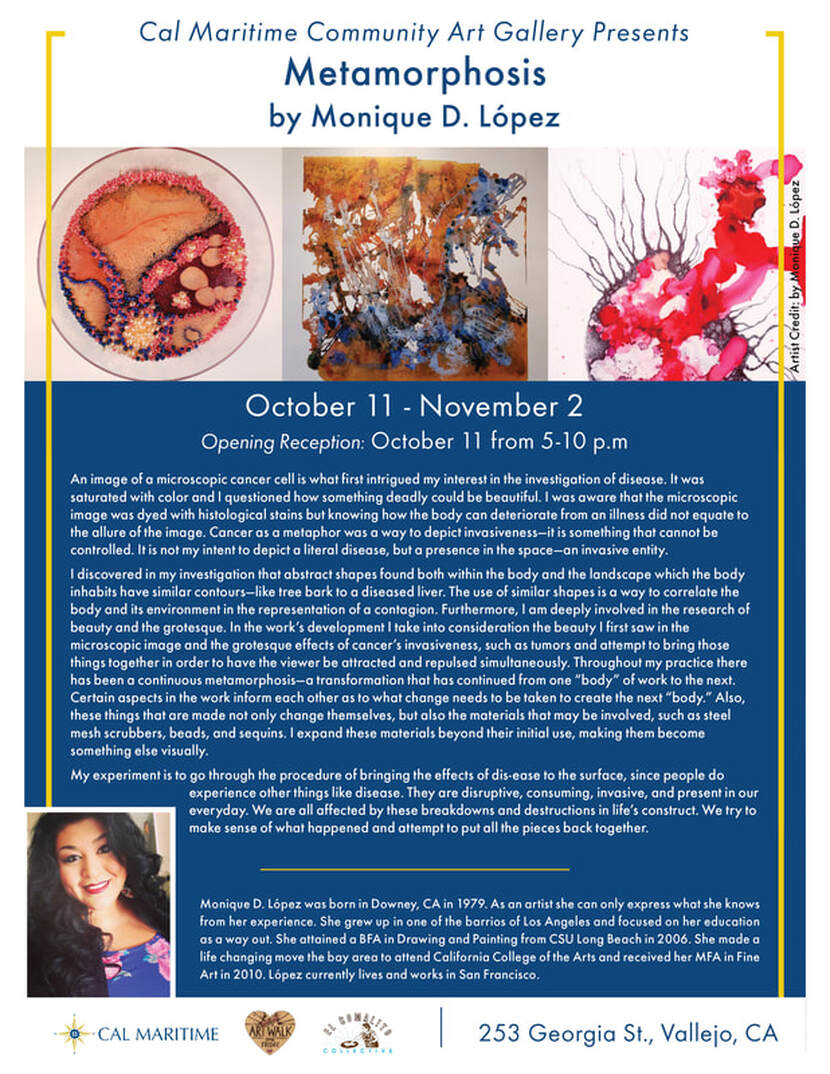We have partnered with the Vallejo Art Walk and Cal Maritime to bring you the Cal Maritime Community Art Gallery that we curate. The gallery is located at 253 Georgia Street, Vallejo CA and is open during the "Vallejo Food & Art Walk" and Saturdays from 10am - 2pm or by appointment.
CONTENT ADVISORY FOR EXHIBIT IN THE WARDROOM:
“Reconstructed: A Breast Cancer Documentation Project” contains graphic but real images of the effects of breast cancer that some may find upsetting, shocking or overwhelming. The artist documented her breast cancer journey through a real and uncensored lens. Please take care of yourselves and others as needed.
October is Breast Cancer Awareness month so we have partnered with 3 artists who have personal connections to the disease. Arleene is a previvor currently working through her genetic cancer mutations. Monica is a breast cancer survivor who has documented her journey in an uncensored way. Monique is an ally who has lost family members to breast cancer and who has a genetic predisposition herself.
_____________
"Invisible" by Arleene Correa Valencia
Arleene Correa Valencia is a Mexican interdisciplinary artist working in San Francisco California. Her artwork is both an exploration and explanation of identity as a person of color living on the margins of society. Her experience as an undocumented woman of color who is battling the consequences of her genetic cancer mutation inform her work. Deriving from her own history of migration and her experienced as an “illegal alien” she uses painting, installation, sculpture and embroidery to question immigration, discrimination, hardship and inequality in her community. Correa de Valencia is proud to present works that aim to celebrate, acknowledge and validate her community’s strength and resilience.
Bio: Arleene Correa Valencia is a Mexican interdisciplinary artist from Napa, CA. Correa-Valencia received her BFA from California College of the Arts spring of 2018 and is now back at CCA working on her MFA. In 1997 Valencia and her family were forced to leave their hometown in Arteaga, Michoacan, Mexico, and migrated to Napa. Having lived her entire life in the United States under an “illegal” status, Correa-Valencia uses this experience to draw upon themes of immigration, human rights, hardship, discrimination and inequality. Her artwork is currently addressing issues local to the world-class wine region in which she was raised. Acknowledging her own privilege, as a DACA recipient, Correa-Valencia uses this as a platform to speak about issues in the community that are ignored and silenced. Through her artwork Correa-Valencia aims to celebrate, acknowledge and validate her community's struggles, their strength and resilience.
www.correavalencia.com
arleenecorreavalencia@gmail.com
@arleenieeee
__________________
"Reconstructed: A Breast Cancer Documentation Project" by Monica Haro
I’ve been a lifelong photography fan and documenter. I’ve enjoyed photography classes over the years, spent hours in darkrooms, and worked in photo labs. I’m a visual person foremost; I never tire of looking at photographic images, or just stuff for that matter! When I was diagnosed with breast cancer, I lost my desire to take pictures with my usual enthusiasm. However, I found myself documenting quick face and body selfies, as well as snapshots of my surroundings with my iPhone as I navigated cancer. I often took these pictures in astonishment. Did I really look like this? Am I really sitting in a medical facility for the fourth time in one week? Another surgery? Another needle? I could better express what was happening to me with a photo than I could articulate with words during this time. It wasn’t until two years post diagnosis that I was going through my phone photos and realized I had a story to tell with them. The photos brought back feelings of despondency. I was reminded of my fear, physical changes, and how decades long marriage with my husband ended during cancer. I remember how I wanted to hurry up through all this cancer stuff and live some other life. This documentation project of photos and items that “collage” the walls of the gallery are a small diary of my life as it unraveled into these different moments forming another new normal. If you have viewed my exhibit the past two years, thank you. Each year, more has been added to my breast cancer narrative. The post cancer life doesn’t end. It’s been both good and bad, and that’s okay. It’s good to have life. I appreciate you coming to see this exhibit. Each breast cancer experience is unique. This is mine. Everyone is aware of breast cancer, but my intention with sharing my experience it to make people aware on another level. There are legions of women like me, diagnosed at age 45 or under, who are now marked with their version of a breast cancer life and all the complicated psychological, physical, and sexual health layers that come with it. Thank you for your time viewing the exhibit and the accompanying memorial in honor of the Stage 4 metastatic breast cancer community members that have died.
Monica was born and raised in the Bay Area where she is currently raising her son. Monica was diagnosed with stage 3C hormone positive invasive lobular carcinoma in September of 2014. She loves staying connected to her community through her work as Community Guide for Breast Cancer Healthline, a support and social app. Monica feels fortunate to volunteer on the board of directors for Bay Area Young Survivors (BAYS). Monica loves to write, take pictures, and make collages as her creative outlets.
____________
Metamorphosis by Monique D. López
An image of a microscopic cancer cell is what first intrigued my interest in the investigation of disease. It was saturated with color and I questioned how something deadly could be beautiful. I was aware that the microscopic image was dyed with histological stains but knowing how the body can deteriorate from an illness did not equate to the allure of the image. Cancer as a metaphor was a way to depict invasiveness—it is something that cannot be controlled. It is not my intent to depict a literal disease, but a presence in the space—an invasive entity.
I discovered in my investigation that abstract shapes found both within the body and the landscape which the body inhabits have similar contours—like tree bark to a diseased liver. The use of similar shapes is a way to correlate the body and its environment in the representation of a contagion. Furthermore, I am deeply involved in the research of beauty and the grotesque. In the work’s development I take into consideration the beauty I first saw in the microscopic image and the grotesque effects of cancer’s invasiveness, such as tumors and attempt to bring those things together in order to have the viewer be attracted and repulsed simultaneously. Throughout my practice there has been a continuous metamorphosis—a transformation that has continued from one “body” of work to the next. Certain aspects in the work inform each other as to what change needs to be taken to create the next “body.” Also, these things that are made not only change themselves, but also the materials that may be involved, such as steel mesh scrubbers, beads, and sequins. I expand these materials beyond their initial use, making them become something else visually.
My experiment is to go through the procedure of bringing the effects of dis-ease to the surface, since people do experience other things like disease. They are disruptive, consuming, invasive, and present in our everyday. We are all affected by these breakdowns and destructions in life’s construct. We try to make sense of what happened and attempt to put all the pieces back together.
“Reconstructed: A Breast Cancer Documentation Project” contains graphic but real images of the effects of breast cancer that some may find upsetting, shocking or overwhelming. The artist documented her breast cancer journey through a real and uncensored lens. Please take care of yourselves and others as needed.
October is Breast Cancer Awareness month so we have partnered with 3 artists who have personal connections to the disease. Arleene is a previvor currently working through her genetic cancer mutations. Monica is a breast cancer survivor who has documented her journey in an uncensored way. Monique is an ally who has lost family members to breast cancer and who has a genetic predisposition herself.
_____________
"Invisible" by Arleene Correa Valencia
Arleene Correa Valencia is a Mexican interdisciplinary artist working in San Francisco California. Her artwork is both an exploration and explanation of identity as a person of color living on the margins of society. Her experience as an undocumented woman of color who is battling the consequences of her genetic cancer mutation inform her work. Deriving from her own history of migration and her experienced as an “illegal alien” she uses painting, installation, sculpture and embroidery to question immigration, discrimination, hardship and inequality in her community. Correa de Valencia is proud to present works that aim to celebrate, acknowledge and validate her community’s strength and resilience.
Bio: Arleene Correa Valencia is a Mexican interdisciplinary artist from Napa, CA. Correa-Valencia received her BFA from California College of the Arts spring of 2018 and is now back at CCA working on her MFA. In 1997 Valencia and her family were forced to leave their hometown in Arteaga, Michoacan, Mexico, and migrated to Napa. Having lived her entire life in the United States under an “illegal” status, Correa-Valencia uses this experience to draw upon themes of immigration, human rights, hardship, discrimination and inequality. Her artwork is currently addressing issues local to the world-class wine region in which she was raised. Acknowledging her own privilege, as a DACA recipient, Correa-Valencia uses this as a platform to speak about issues in the community that are ignored and silenced. Through her artwork Correa-Valencia aims to celebrate, acknowledge and validate her community's struggles, their strength and resilience.
www.correavalencia.com
arleenecorreavalencia@gmail.com
@arleenieeee
__________________
"Reconstructed: A Breast Cancer Documentation Project" by Monica Haro
I’ve been a lifelong photography fan and documenter. I’ve enjoyed photography classes over the years, spent hours in darkrooms, and worked in photo labs. I’m a visual person foremost; I never tire of looking at photographic images, or just stuff for that matter! When I was diagnosed with breast cancer, I lost my desire to take pictures with my usual enthusiasm. However, I found myself documenting quick face and body selfies, as well as snapshots of my surroundings with my iPhone as I navigated cancer. I often took these pictures in astonishment. Did I really look like this? Am I really sitting in a medical facility for the fourth time in one week? Another surgery? Another needle? I could better express what was happening to me with a photo than I could articulate with words during this time. It wasn’t until two years post diagnosis that I was going through my phone photos and realized I had a story to tell with them. The photos brought back feelings of despondency. I was reminded of my fear, physical changes, and how decades long marriage with my husband ended during cancer. I remember how I wanted to hurry up through all this cancer stuff and live some other life. This documentation project of photos and items that “collage” the walls of the gallery are a small diary of my life as it unraveled into these different moments forming another new normal. If you have viewed my exhibit the past two years, thank you. Each year, more has been added to my breast cancer narrative. The post cancer life doesn’t end. It’s been both good and bad, and that’s okay. It’s good to have life. I appreciate you coming to see this exhibit. Each breast cancer experience is unique. This is mine. Everyone is aware of breast cancer, but my intention with sharing my experience it to make people aware on another level. There are legions of women like me, diagnosed at age 45 or under, who are now marked with their version of a breast cancer life and all the complicated psychological, physical, and sexual health layers that come with it. Thank you for your time viewing the exhibit and the accompanying memorial in honor of the Stage 4 metastatic breast cancer community members that have died.
Monica was born and raised in the Bay Area where she is currently raising her son. Monica was diagnosed with stage 3C hormone positive invasive lobular carcinoma in September of 2014. She loves staying connected to her community through her work as Community Guide for Breast Cancer Healthline, a support and social app. Monica feels fortunate to volunteer on the board of directors for Bay Area Young Survivors (BAYS). Monica loves to write, take pictures, and make collages as her creative outlets.
____________
Metamorphosis by Monique D. López
An image of a microscopic cancer cell is what first intrigued my interest in the investigation of disease. It was saturated with color and I questioned how something deadly could be beautiful. I was aware that the microscopic image was dyed with histological stains but knowing how the body can deteriorate from an illness did not equate to the allure of the image. Cancer as a metaphor was a way to depict invasiveness—it is something that cannot be controlled. It is not my intent to depict a literal disease, but a presence in the space—an invasive entity.
I discovered in my investigation that abstract shapes found both within the body and the landscape which the body inhabits have similar contours—like tree bark to a diseased liver. The use of similar shapes is a way to correlate the body and its environment in the representation of a contagion. Furthermore, I am deeply involved in the research of beauty and the grotesque. In the work’s development I take into consideration the beauty I first saw in the microscopic image and the grotesque effects of cancer’s invasiveness, such as tumors and attempt to bring those things together in order to have the viewer be attracted and repulsed simultaneously. Throughout my practice there has been a continuous metamorphosis—a transformation that has continued from one “body” of work to the next. Certain aspects in the work inform each other as to what change needs to be taken to create the next “body.” Also, these things that are made not only change themselves, but also the materials that may be involved, such as steel mesh scrubbers, beads, and sequins. I expand these materials beyond their initial use, making them become something else visually.
My experiment is to go through the procedure of bringing the effects of dis-ease to the surface, since people do experience other things like disease. They are disruptive, consuming, invasive, and present in our everyday. We are all affected by these breakdowns and destructions in life’s construct. We try to make sense of what happened and attempt to put all the pieces back together.




